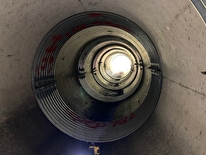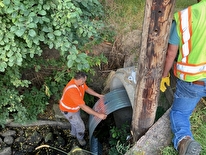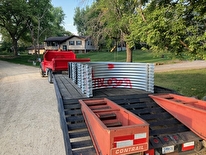BY ALAN FORSBERG, P.E., RETIRED BLUE EARTH COUNTY ENGINEER
Precast concrete culverts are strong, long-lasting pipes that carry water under roads and railroads. They were developed in the early 1900s and have been used extensively ever since, especially for roads and railroads where their longevity means the traveled way will not need to be interrupted for pipe repair or replacement.
However, these early pipes had a weakness—the joints between sections may open with time, allowing earth embankment materials to filter through the separation and be carried away by the flowing water. This creates a hole in the road, a maintenance item, and a safety hazard. The separation may be caused by freeze-thaw cycles, embankment settlement, low fills with heavy traffic, faulty installation, or other causes of movement in the embankment.
Once this problem was recognized, steel ties—essentially long U bolts connecting the pipe sections—were installed on the exterior of pipes large enough to provide workers access to install the washers and nuts. Later, methods were developed to tie smaller-diameter pipe sections together with steel bolts. This solved the separation problem for pipes placed in recent decades. However, there are still a significant number of pipes without ties, especially on county and township roads, where the problem needs to be addressed.
Repair options
I would like to share what I learned from discussions about repairing this separation problem with several county engineers, a township officer, and a MnDOT district maintenance engineer.
Public works agencies have developed a number of options. Choosing the best one involves answering these questions:
- Paved or aggregate-surfaced road?
- Depth of the pipe buried in the embankment?
- Condition of the pipe?
- Depth of standing or flowing water in the pipe?
- Traffic volume?
- Critical road for truck, school bus, mail route, emergency vehicle access?
- All joints separated, or just one or a few?
Options developed—roughly in order of cost—include:
- Excavate to the pipe separation and place concrete, metal, and/or geotextile fabric over the separation. Cost, quick road closure, aggregate surface, and shallow burial depth make this the first option. This is a short- or mid-term repair since the pipe can separate again or the patch can deteriorate.



- Place internal seal at separated joints—a relatively new method. An example is a galvanized steel band placed in overlapping halves at the separated joint. After placement, the bands are expanded by bolts. Sealing material can be placed between the bands and concrete pipe. This option does not disturb pavement or traffic, is low cost, and can be installed with the agency’s maintenance crew. The width of the bands allows for some pipe movement and also helps tie the pipe sections together. Installation requires a pipe diameter large enough to permit worker access and low or no flow (see photos).
- Excavate, remove the pipe, relay the old pipe with ties and geotextile over joints. Good pipe condition, aggregate surface, and shallow depth favor this method. It is a long- lasting repair; however, the road must be closed during the work. If only the apron and end sections are separated, excavation and tying can be confined to the ditch and shoulder, minimizing the effect on traffic.
- Reline with steel, plastic, or concrete pipe by inserting the lining pipe inside the old pipe. This method does not disturb the driving surface; it provides the “life” of a new pipe but reduces hydraulic capacity somewhat. It requires access for equipment on both ends. One county used salvaged-steel natural gas pipe when available. This could be problematic because the stiff steel pipe could not easily follow the alignment of the old pipe. A newer relining method involves placing a liner layered with resin inside the old pipe. The liner is inflated with air to conform to the old pipe and then cured with heat or ultraviolet light. The liner is thin and smooth and so has minimum or even positive hydraulic capacity.
- Excavate, remove, replace with new concrete pipe with ties and geotextile over joints or steel or plastic pipe. Costly, especially for high fills, and disturbs pavement and traffic flow, but provides life of a new pipe.
- Bore new concrete pipe adjacent to old, fill old pipe with sand or concrete. Costly but does not disturb driving surface and provides life of a new pipe. High fills feasible. A larger pipe can be bored if additional hydraulic capacity is needed.
Manure pipeline requests
In some parts of the state, farmers request a permit to place a manure pipeline through the centerline culvert. The steel ties, washers, and nuts protruding inside the culvert may puncture their manure pipeline, especially in the smaller diameter culverts. The permit should state that risk of damage to their manure pipeline—or flooding due to the pipeline partially obstructing the culvert—is the permit holder’s responsibility. Considerations for reducing the manure line damages include placing a protective shield over the protruding tie, placing the tie on the inside of the culvert with the protruding bolt on the outside, and the farmer placing a steel liner over the manure pipeline.
A wise choice
Which is best for your agency’s separated pipe? A wise choice requires review of cost and traffic impacts, capabilities of your maintenance forces, experience, and judgment.